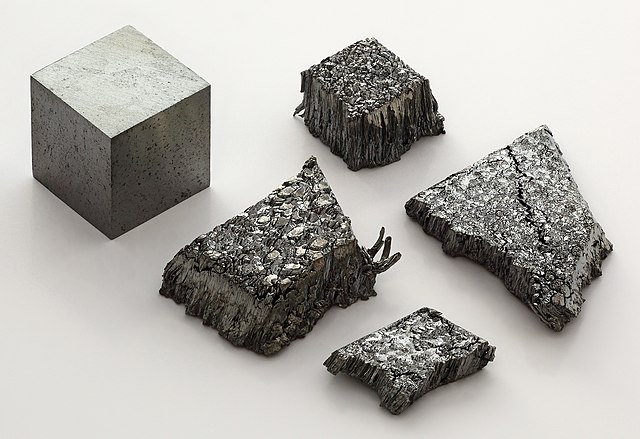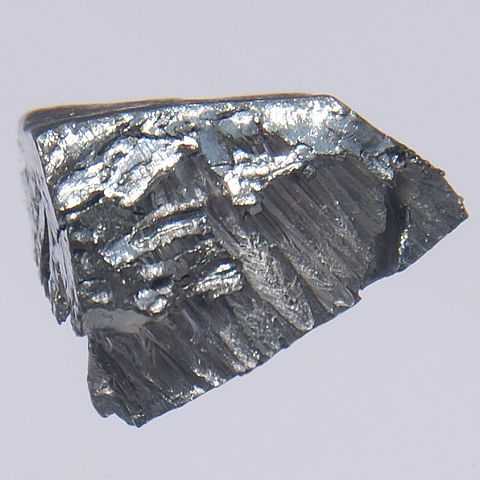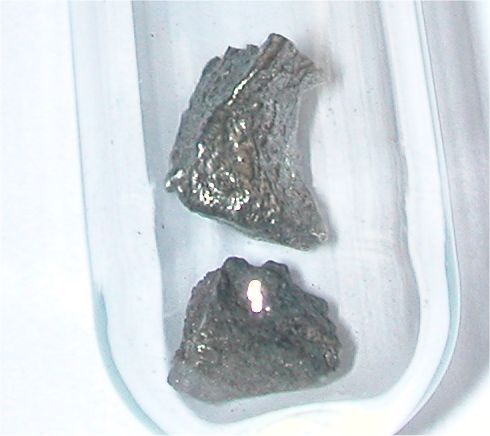Lutetium is a chemical element of the periodic table with the symbol Lu and atomic number 71. It belongs to the lanthanide group and is the last element in the lanthanide series.
Lutetium is a silvery-white metal with a density of 9.84 g/cm3 and a melting point of 1925°C. It is the fifth densest element and has the highest melting point of all lanthanides.
Introduction
Lutetium is a relatively rare element and has many unique properties. It has a high neutron capture cross-section, which makes it an ideal candidate for nuclear reactor fuel. It also has a strong ability to absorb gamma rays, making it useful in radiation therapy.
It is also highly resistant to corrosion and has a strong affinity for oxygen. This makes it useful for the production of oxygen compounds and it is also used as a stabilizing agent in alloys.
The history of Lutetium dates back to the early 1900s. It was first identified by Georges Urbain in 1907 when he separated ytterbium from a sample of yttrium oxide. However, he could not separate lutetium from his ytterbium sample and it was not until 1923 that it was re-discovered by Charles James.
Lutetium’s atomic structure is composed of 71 protons, 71 electrons and 108 neutrons. It has seven naturally occurring isotopes, ranging from Lu-143 to Lu-175, with the most common isotope being Lu-177. Its electron configuration is 1s2 2s2 2p6 3s2 3p6 4s2 3d10 4p6 5s2 4d10 5p6 6s2 4f14 5d1 6p6 7s2.
Compounds and alloys of Lutetium are also used in a variety of industrial applications. It is a component of the catalysts used in the production of synthetic rubber and is also used in the manufacture of high-temperature alloys and as a stabilizing agent in alloys. Common compounds of lutetium include lutetium oxychloride, lutetium fluoride, lutetium-177 oxide, and lutetium-178 chloride.

Lutetium (Lu) sublimed, dendritic
The oxidation states of lutetium range from +3 to +5. It is most stable in its +3 oxidation state, which is why it is used in compounds such as lutetium oxychloride and lutetium-178 chloride. The +4 oxidation state is also relatively stable and is used in compounds such as lutetium fluoride.
Lutetium is found naturally only in trace amounts in minerals such as monazite and xenotime. It is also found in the earth’s crust in small amounts but is not found in large enough quantities to be commercially viable.
The safety and hazards of lutetium must be taken into consideration when working with the element. Inhalation of lutetium dust can cause serious health problems, such as respiratory tract irritation. It is also highly toxic if swallowed, so protective equipment must be worn when handling the element.
Finally, some interesting facts about lutetium are that it has a strong ability to absorb gamma rays, it is highly resistant to corrosion, and it has the highest melting point of all the lanthanides. It is also used in the production of oxygen compounds and has a number of uses outside of chemistry.
In addition, Lutetium’s unique properties can give it some “superpowers” when used in combination with other elements.
Atomic Structure
Lutetium is a chemical element belonging to the Rare Earths group of elements and is represented by the symbol ‘Lu’. It is one of the heaviest elements in the periodic table with an atomic number of 71 and is located at the bottom of the lanthanide series. It is a soft, silvery-white metal that is malleable and ductile.
Atomic structure of lutetium is composed of protons and neutrons, which are present in the nucleus, and electrons, which orbit the nucleus. It has 71 protons in its nucleus, which are responsible for its atomic number. The number of neutrons in its nucleus varies, depending on the isotope present. Lutetium has seven naturally occurring isotopes, ranging from Lu-177 to Lu-183.
Its electron configuration is represented by [Xe] 4f14 5d1 6s2. This indicates that the outermost shell contains two electrons in the 6s orbital, one electron in the 5d orbital, and fourteen electrons in the 4f orbital. This electron configuration is similar to that of other rare-earth elements and gives lutetium its chemical properties.
Lutetium is a member of the lanthanide series of elements, and as such, shares many properties with other lanthanide elements. It has a very low boiling point and a low melting point. Its boiling point is 3675 K (3402 °C, 6156 °F) and its melting point is 1663 K (1390 °C, 2514 °F).
It has a crystal structure similar to that of other lanthanide elements and is cubic in shape. Its density is 9.841 g/cm3 and its atomic radius is 2.26 angstroms.
Overall, lutetium is a chemical element with unique properties and a complex atomic structure. Its protons, neutrons, and electrons come together to form a stable element that is an important part of science and industry. Its abundance in the Earth’s crust is relatively low, making it a rare element.
Compounds and Alloys
Lutetium is a chemical element with a number of interesting properties and a variety of compounds and alloys. It is important to understand the compounds and alloys that can be created with lutetium in order to benefit from its unique characteristics.
Common Compounds:
Lutetium oxide (Lu2O3) is the most commonly used compound of lutetium, and is a white powder that is stable at room temperature and pressure.
Lu2O3 is used in a variety of industries, including ferroelectrics, optics, and lasers. Other lutetium compounds include lutetium chloride (LuCl3), lutetium fluoride (LuF3), and lutetium sulfate (Lu2(SO4)3).
Industrial Applications:
Lutetium compounds have a variety of industrial applications. Lu2O3 is used in the electronics industry due to its ability to absorb infrared radiation. It is also used in the production of flat-panel displays and as an abrasive material. Lutetium chloride is used in photography, as it is sensitive to infrared light and can be used to detect invisible infrared light.
Lutetium sulfate is used in the production of synthetic diamonds, as it acts as a catalyst in the high-pressure, high-temperature process of diamond growth.
Common Alloys:
Lutetium is often combined with other elements to create alloys. One common alloy is lutetium-hafnium (LuHf), which is used in jet engines and nuclear reactors. This alloy has a low coefficient of thermal expansion, making it ideal for use in applications that require high temperatures and pressures.
Another common alloy is lutetium-titanium (LuTi), which is used in optics and aerospace applications due to its high thermal stability and low reactivity.
Lutetium has a variety of compounds and alloys that can be used in a number of industries. Its unique properties make it a valuable element in a number of applications, and its alloys allow for further customization to meet specific needs.
By combining lutetium with other elements, a wide range of compounds and alloys can be created with a variety of uses.

Oxidation States
The oxidation states of lutetium are very important in understanding its chemistry. Lutetium is an element in the lanthanide series, and its oxidation states are +3, +4, and +7. In its most common oxidation state, +3, lutetium has a filled outer f orbital.
The common oxidation states of lutetium are +3 and +4. In its +3 oxidation state, lutetium has a filled outer f orbital and a stable 6s2 electron configuration. In its +4 oxidation state, it has a filled outer f orbital and a stable 5d1 6s2 electron configuration.
The +7 oxidation state of lutetium is a bit less common than its +3 and +4 states, but is still important. In this state, lutetium has a filled outer f orbital and a stable 5d1 6s2 6p1 electron configuration. This state is also sometimes represented as Lu(VIII).
The +3 oxidation state of lutetium often forms compounds with oxygen, and is often used in oxidation reactions. For example, the oxide compound of lutetium and oxygen (Lu2O3) is used in a variety of industrial processes, including catalysis.
The +4 oxidation state of lutetium is also important, and is often used in reduction reactions. For example, lutetium tetraiodide (LuI4) is often used in the production of pharmaceuticals.
The +7 oxidation state of lutetium is also important, and is often used in complex reactions. For example, lutetium(VII) oxide (Lu2O7) is used in the production of specialty glass, and lutetium(VII) fluoride (LuF7) is used in the production of optical lenses.
While lutetium’s oxidation states are important in understanding its chemistry, it is important to note that all of its oxidation states are not chemically stable. The +2 oxidation state is not stable, and will quickly decompose to the +3 or +4 state. This means that it is not possible to use lutetium in the +2 oxidation state in reactions.
Natural Occurrence
Lutetium is a rare and precious chemical element found in the periodic table, and it is not found in nature in its elemental form. Instead, it is found as a compound in the form of lutetium oxide, which is sometimes referred to as lutecia.
Lutecia is found in small amounts in rocks and minerals, such as monazite, xenotime, and euxenite. It is also found in trace amounts in zircon and in other rare and precious gems.
The most abundant source of lutetium is monazite, which is a silicate mineral that contains lutetium-176, lutetium-175, and other rare earth elements. The element is present in monazite in concentrations of up to 0.7 percent. Xenotime, which is a phosphate mineral, is also a common source of lutetium. It is found in concentrations of up to 0.1 percent in some samples.
Euxenite is another source of lutetium. It is a rare and complex mineral composed of several rare earth elements, including lutetium. It is found in concentrations of up to 0.2 percent. Zircon is yet another source of the element. It is found in concentrations of up to 0.05 percent.
Lutetium can also be found in trace amounts in other rare and precious gems, such as rubies and sapphires. It is found in concentrations of up to 0.1 percent in some samples.
In addition to these sources, lutetium can be recovered from nuclear waste streams in nuclear power plants. It is also produced as a by-product of the industrial recovery of uranium and thorium.
In terms of natural abundance, lutetium is the rarest of all the lanthanides, with an estimated abundance of 0.0021 parts per million in the Earth’s crust. This makes it one of the rarest elements on the planet, with a concentration of just 0.00004 percent.
Lutetium can also be found in trace amounts in meteorites. It is believed to be a primordial element that was formed during the Big Bang, but its abundance is unknown due to its rarity.
Safety and Hazards
Lutetium is a highly toxic chemical element and any exposure to it must be avoided. It has been established that the element is a human health hazard and can cause severe poisoning if ingested, breathed in, or absorbed through the skin.
The health hazards associated with lutetium include irritation of the eyes, skin, and respiratory system; damage to the liver, kidney, and heart; and central nervous system depression. In severe cases, lutetium can cause death.
Exposure to lutetium can also cause significant environmental damage. Studies have shown that lutetium can have a detrimental impact on the soil and water, as well as on plant and animal life.
It is also essential to keep lutetium sealed away from the environment in an appropriate container, such as a glass jar or sealed metal drum. The container must also be properly labeled with information about the hazard.
In the event of a fire, lutetium must be kept away from water, as this can release hazardous gases into the air. It is also important to keep a fire extinguisher handy in case of an emergency.
In conclusion, lutetium is a highly toxic chemical element and must be handled with extreme caution. Proper safety protocols, such as wearing protective clothing and keeping lutetium sealed away from the environment, must be observed at all times.
Interesting Facts
Lutetium is an interesting and unusual chemical element that has many interesting properties and uses. Knowing a few interesting facts about this element can help you appreciate its various uses and understand why it is so important.
One of the most amazing things about lutetium is its ability to absorb energy and release it later. This is known as light emission and is used in various scientific studies. It can also be used in medical imaging to help doctors detect tumors and other diseases.
Another interesting property of lutetium is its ability to concentrate in certain areas. This is called lutetium concentration and can be used to identify mineral deposits, which can help scientists understand the geology of a particular area.
Another interesting fact about lutetium is its use as an additive in nuclear power plants. Lutetium is used to help control the reaction of the nuclear fuel, which helps keep the plant safe. It is also used in nuclear reactors to help regulate the amount of radiation that the reactor emits.
Lutetium is also used as a catalyst in chemical reactions. It helps speed up chemical processes and can be used in the production of plastics and other industrial materials. It is also used in the medical field to help break down certain proteins and to help speed up the body’s healing process.
In addition, lutetium is also used in certain medical imaging techniques, including PET scans. The element absorbs gamma radiation and then releases it, which helps to create images of the inside of the human body. This allows doctors to diagnose and treat certain diseases.
Finally, lutetium is also used in certain types of lasers. It is used to help control the beam of light, which helps make laser treatments more precise. This is especially effective in laser eye surgery and other medical laser treatments.
By understanding a few interesting facts about lutetium, it is easy to see that this element is an incredibly important part of our modern world. It is used in a variety of industries and applications and can help us better understand the world around us.

Facts
The element originally was named lutecium
Lutetium is a chemical element with the symbol Lu
Its atomic number is 71
It is a silvery white metal, which resists corrosion in dry air, but not in moist air.
Lutetium is the last element in the lanthanide series
It is traditionally counted among the rare earth elements
Lutetium atoms are the smallest of any of the lanthanides.
Three separate scientists discovered lutetium in 1907, independent of each other.
The mineral ytterbia was the source of lutetium discovered by the three researchers
Lutetium occurs on the Earth in form of two isotopes: lutetium-175 and lutetium-176.
Only one of those isotopes, lutetium-175, is stable, making it a monoisotopic element.
The unstable isotope, lutetium-176, has a half-life of almost 38 trillion years.
Only 2.5% of the lutetium found on Earth is in the unstable form.
Lutetium is the hardest lanthanide element.
It’s also the most expensive lanthanide.
The world production of lutetium (in the form of oxide) is about 10 tonnes per year.
Lutetium is only available in the Earth’s crust at about 0.5 milligrams per kilogram.
It is one of the rarest and most expensive of the rare earth metals with the price about US$10,000 per kilogram
The element also has 43 known nuclear isomers
Data
| Lutetium | ||||||||||||||||||||||||||||||||||||
|---|---|---|---|---|---|---|---|---|---|---|---|---|---|---|---|---|---|---|---|---|---|---|---|---|---|---|---|---|---|---|---|---|---|---|---|---|
| Pronunciation | lew-TEE-shee-əm | |||||||||||||||||||||||||||||||||||
| Appearance | silvery white | |||||||||||||||||||||||||||||||||||
| Standard atomic weight Ar°(Lu) | ||||||||||||||||||||||||||||||||||||
|
||||||||||||||||||||||||||||||||||||
| Lutetium in the periodic table | ||||||||||||||||||||||||||||||||||||
| Atomic number (Z) | 71 | |||||||||||||||||||||||||||||||||||
| Group | group 3 | |||||||||||||||||||||||||||||||||||
| Period | period 6 | |||||||||||||||||||||||||||||||||||
| Block | d-block | |||||||||||||||||||||||||||||||||||
| Electron configuration | [Xe] 4f14 5d1 6s2 | |||||||||||||||||||||||||||||||||||
| Electrons per shell | 2, 8, 18, 32, 9, 2 | |||||||||||||||||||||||||||||||||||
| Physical properties | ||||||||||||||||||||||||||||||||||||
| Phase at STP | solid | |||||||||||||||||||||||||||||||||||
| Melting point | 1925 K (1652 °C, 3006 °F) | |||||||||||||||||||||||||||||||||||
| Boiling point | 3675 K (3402 °C, 6156 °F) | |||||||||||||||||||||||||||||||||||
| Density (near r.t.) | 9.841 g/cm3 | |||||||||||||||||||||||||||||||||||
| when liquid (at m.p.) | 9.3 g/cm3 | |||||||||||||||||||||||||||||||||||
| Heat of fusion | ca. 22 kJ/mol | |||||||||||||||||||||||||||||||||||
| Heat of vaporization | 414 kJ/mol | |||||||||||||||||||||||||||||||||||
| Molar heat capacity | 26.86 J/(mol·K) | |||||||||||||||||||||||||||||||||||
Vapor pressure
|
||||||||||||||||||||||||||||||||||||
| Atomic properties | ||||||||||||||||||||||||||||||||||||
| Oxidation states | 0,[2] +1, +2, +3 (a weakly basic oxide) | |||||||||||||||||||||||||||||||||||
| Electronegativity | Pauling scale: 1.27 | |||||||||||||||||||||||||||||||||||
| Ionization energies |
|
|||||||||||||||||||||||||||||||||||
| Atomic radius | empirical: 174 pm | |||||||||||||||||||||||||||||||||||
| Covalent radius | 187±8 pm | |||||||||||||||||||||||||||||||||||
| Other properties | ||||||||||||||||||||||||||||||||||||
| Natural occurrence | primordial | |||||||||||||||||||||||||||||||||||
| Crystal structure | hexagonal close-packed (hcp) | |||||||||||||||||||||||||||||||||||
| Thermal expansion | poly: 9.9 µm/(m⋅K) (at r.t.) | |||||||||||||||||||||||||||||||||||
| Thermal conductivity | 16.4 W/(m⋅K) | |||||||||||||||||||||||||||||||||||
| Electrical resistivity | poly: 582 nΩ⋅m (at r.t.) | |||||||||||||||||||||||||||||||||||
| Magnetic ordering | paramagnetic[3] | |||||||||||||||||||||||||||||||||||
| Young’s modulus | 68.6 GPa | |||||||||||||||||||||||||||||||||||
| Shear modulus | 27.2 GPa | |||||||||||||||||||||||||||||||||||
| Bulk modulus | 47.6 GPa | |||||||||||||||||||||||||||||||||||
| Poisson ratio | 0.261 | |||||||||||||||||||||||||||||||||||
| Vickers hardness | 755–1160 MPa | |||||||||||||||||||||||||||||||||||
| Brinell hardness | 890–1300 MPa | |||||||||||||||||||||||||||||||||||
| CAS Number | 7439-94-3 | |||||||||||||||||||||||||||||||||||
| History | ||||||||||||||||||||||||||||||||||||
| Naming | after Lutetia, Latin for: Paris, in the Roman era | |||||||||||||||||||||||||||||||||||
| Discovery | Carl Auer von Welsbach and Georges Urbain (1906) | |||||||||||||||||||||||||||||||||||
| First isolation | Carl Auer von Welsbach (1906) | |||||||||||||||||||||||||||||||||||
| Named by | Georges Urbain (1906) | |||||||||||||||||||||||||||||||||||
|
||||||||||||||||||||||||||||||||||||
